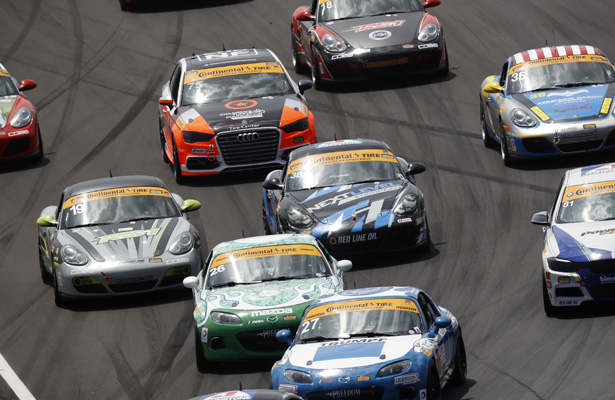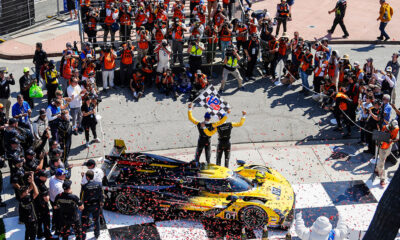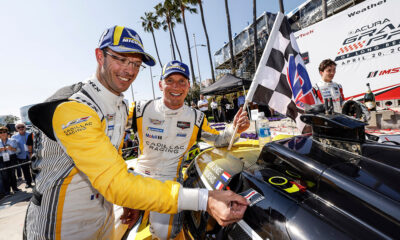
Photo: Mike Levitt/IMSA
With a revised class structure in the Continental Tire SportsCar Challenge, the launch of LMP3 in North America and all-new LMP2/DPi regulations for the WeatherTech SportsCar Championship, 2017 is all about change in IMSA.
Sportscar365 caught up with Travis Roffler, director of marketing for Continental Tire, to get his thoughts on the evolution.
LMP3 had been considered for Continental Tire Challenge. What are your thoughts on the series remaining production-based only?
“For Continental, when we go back to 2010 when we came on board, it was about real cars and real racing and cars that look like real cars. So to me, the entry of a prototype into that series, I don’t know if it would be detrimental but it doesn’t hold to the grassroots nature of that series as we envisioned it in the beginning.”
Do you feel the integration of GT4, with the amount of current and future manufacturer involvement, will help the class regain the strength it had in previous years?
“The fact that GT4 is a global platform, there’s many, many manufacturers that have cars either in the works or already homologated for the GT4 class… And when you see the list of manufacturers, it’s super exciting.
“For GS, to me, the future is very bright because with that structure in that class, and all the manufacturers involved in GT4 globally, it just swings the door wide open. It’s still going to be growing.
“I don’t think we’re going to [immediately] see car counts back to where they were in 2011, 2012, but that’s the focus: getting GS back to it’s swagger, getting back up there so we can fill a field full of ST and GS cars.”
What are your thoughts on the four-hour endurance races at Daytona and Mazda Raceway Laguna Seca, and reduction in other rounds to two-hour races?
“To me the selection of those two races, and then pulling the rest of the series back to two hours makes logical sense. It frees up time within the race weekend so we can compact some of these events to less days. You practice and qualify on the same day, race the next day, and get out.
“When you talk to race teams, it’s about the number of days they have to be at the track. So when we make them pull in on Wednesday to practice on Thursday, qualify on Friday, race on Saturday, pull out Sunday, you’ve added thousands of dollars to the weekend. Food, hotels, people, all this stuff…
“We’re trying to look at how we can get to more manageable race weekends. That’s what the overriding theme is from IMSA.”
Do you see the planned integration of TCR marketable, or a challenge for the U.S. market?
“My understanding is that they’re [mainly] five-door hatchbacks. That’s a challenge as those cars have never been popular in the United States.
“As a global [platform] I understand it from a car company and we know from our European heritage that those cars are very popular in Europe. But some of those cars are not even sold here. The Audis, the Mercedes, the BMWs, the hatchbacks, the five-door cars, are not popular at all here in the States.
“I think that’s going to be the question, whether the OE manufacturers are jazzed about bringing cars here, and most importantly, it’s all about the fans. If the fans don’t want to see it, they have the ultimate veto power.
“I’m ecstatic that we’re ahead of the game. We can look at the TCR and see how ST is going to develop and make a logical, defendable decision going into ’18.”
The exclusive tire partner for new-look Prototype Challenge powered by Mazda series has been opened to RFP (Request for Proposal). Does this interest Continental?
“Yes. We will be addressing it. We are interested.”
How has development gone for the new 2017 Prototype tire for the WeatherTech Championship?
“We’re testing with the teams, both with dry and wet [constructions]. Everybody is happy. Ultimately, trying to do BoP for a tire that works as well for a 450-pound heavier DP than a P2 [was difficult].
“I would say we were vocal of our opinion in wanting to create a tire for the P2 car from the onset when they first introduced the car, and we were told it wasn’t a good idea so we didn’t. Now DPi and P2 is [essentially] the same car, same homologation, same weight.
“I think we still need that balance between having a gentlemen racer being able to drive the tire and not burn it up and having a pro be able to race the tire and push it to its edge but not too edgy for a gentlemen driver to control; that’s still our challenge. That’s the challenge for everybody in a spec series.
“We will continue to push and develop the tire, but I think we’re more than set for 2017 for DPi and P2.”
How much of a difference is the tire?
“It’s not a radical change. It’s a taller tire [per the 2017 global LMP2 regulations], so we’ve had to adapt to that, downforce and all of the other stuff. I think we’re well ahead of the game. People are happy with what we’re doing. Tire testing is going very well.”

























